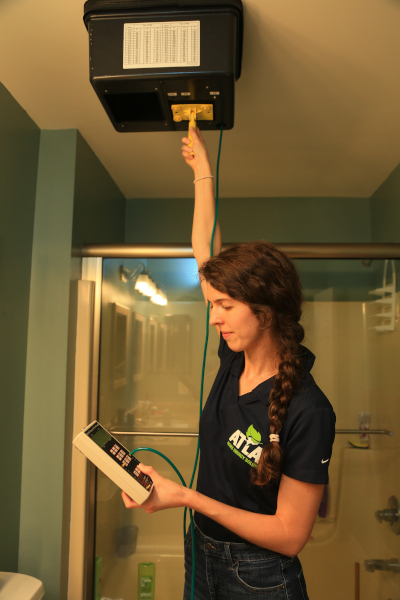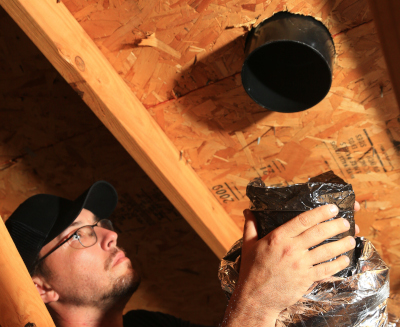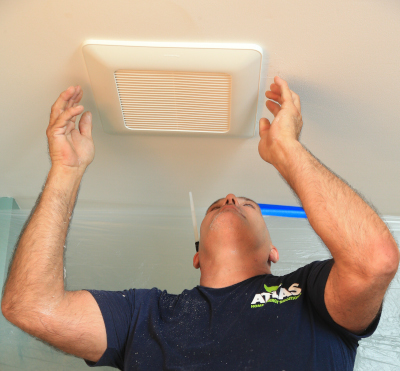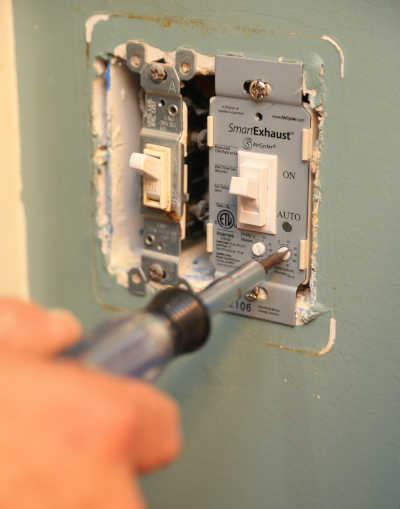

As residential construction methods improve, new homes are being built tighter and better shielded from the outside environment. This is helpful for the comfort and energy efficiency of the building, because the heated/cooled air from the HVAC system stays within the building shell of the house. In a leaky home, the HVAC system would need to keep running constantly to make up for the different temperature of the air coming in from outside. Generally there is agreement between both builders and the Department of Energy that tighter built construction is going to be better in the long run for keeping down energy costs, and building codes have been gradually changing to require a tighter home at the time of construction.
Is it very important; however, to understand the potential drawbacks of making the home “too tight”. If the home isn’t circulating very much outside air, there is a potential for keeping unwanted pollutants in the home without a way for them to get out. Some examples of things you wouldn’t want to keep trapped in your home would be excess humidity, carbon monoxide, VOC’s, or even less harmful things like bad odors. Without fresh air from outside, homes tend to have “stale air”, and generally are not comfortable living spaces.
Luckily, there are some good common sense solutions for providing fresh air to the home, while still making the home as tight and energy efficient as possible!
The introduction of fresh air to the home does not mean an uncontrolled flow of outside air like leaky homes built in the past. The fresh air should be brought in to the home through a mechanically controlled ventilation, rather than relying on leaks in the building to allow fresh air in. Due to the mechanical aspect of the ventilation, the system can work 24/7, whereas older homes were only properly ventilated on a windy day. The control portion of the ventilation also means that homeowners and builders can choose the exact level they want to provide for each home. A relatively simple calculation can show you how many cubic feet of air should be flowing through your fresh air system every hour, to help maintain good indoor air quality, and therefore allow you to seal the other air leaks in the building to make the home as tight and efficient as possible.


We typically take for granted that all bathrooms in newer homes come equipped with an exhaust fan. Prior to exhaust fans being a requirement, bathrooms would at least need to have a window that could be opened to ventilate the space. Bathrooms are the areas in your home that typically have the most need for ventilation, due to the high levels of moisture that accumulate when occupants take showers. In addition to being an easier, more controlled way to ventilate, an exhaust fan offers the advantage of being more efficient than opening a window. Opening a window for ventilation will contribute to a higher utility bill and an uncomfortable home, especially during the winter or summer time. However, the effectiveness of exhaust ventilation depends on the quality of the fan and effectiveness of the fan routing.
Despite having an exhaust fan, there are some bathrooms that still feel humid or worse; they actively are supporting the growth of mold or mildew. The problem is that although exhaust fans have been around for decades, older models tend to be loud and ineffective when it comes to moving air. If your bathroom exhaust fan is not rated to remove at least 50 cubic feet of air per minute, it will not be sufficient to properly ventilate the bathroom.
Another issue that bathroom exhaust fans create is that they are often improperly routed and contribute to the addition of unwanted moisture into the home. High humidity levels in the home is one of the largest contributors to the growth of mold or mildew in the living space. Previous building codes allowed exhaust fans to be vented into a home’s attic or crawlspace, which allowed the moisture from the fans to come right back into the living space. Eventually building code was modernized to require exhaust fans to be routed directly to the outside of the home, to ensure that bathroom exhausts would not have a pathway directly into the building.


There are many different ways to provide fresh air to your home, which have a varying price range. The most efficient way to bring in fresh air to the home is an Energy Recovery Ventilator or a Heat Recovery Ventilator system; however, these systems are potentially going to cost you thousands of dollars to install. A simple method is to both tackle the home’s whole house ventilation and the bathroom ventilation at the same time. A quiet, efficiently running bathroom exhaust fan that runs on an automatic timer, can be a great way to ensure that your home has all the ventilation it requires. Our process of evaluating your home’s leakage and exhaust fans, will allow us to calculate exactly how much ventilation your home needs currently, and how much it will need after any major air sealing project. For the main fresh air system in the home we install the Panasonic Whisper Fan, which is rated to deliver 110 CFM, and is the quietest fan on the market. We ensure that the fan is properly routed outside of the home or any areas that are well connected through the home. We can also install an automatic smart exhaust timer to ensure that the fan ventilates your home without the hassle of having to turn it on manually every time you want to ventilate.
By choosing Atlas Home Energy for your home upgrades, we promise to:
Effective Date: 09/05/2023
This Privacy Policy explains how Atlas Home Energy Solutions collects, uses, and discloses personal information about our customers, prospective customers, and visitors to our website at www.atlashomeenergy.com.
Information collected directly from you: We may collect personal information directly from you, for example through a web form, while scheduling a service, when you contact us for customer support, or upon signing a contract for service. Personal information we collect directly from you may include first and last name, address, email address, and phone number.
Information collected from your device: Our website may use technologies such as cookies, web beacons, pixels, and other similar technologies to automatically collect certain information from your device including, for example, your IP address, date and time of your visit, browser and operating system information, referring website address, and other information about how you interact with the website. Our website may also use cookies and similar technologies to enhance your user experience and enable certain features. Our email campaigns may also use tracking technologies such as web beacons, pixels, and other similar technologies to automatically collect certain information such as IP address, browser type and version, and email engagement statistics.
Information collected from your partners: We may collect personal information about you from our third-party partners and combine it with other information that we collect. Personal information we collect from our partners may include, for example, your demographic information, shopping history, and geographic location.
Personal information collected from you may be used to contact you via SMS Text, Email, or Phone in order to: schedule you for an estimate or consultation, respond to customer service inquiries, complete home improvement services, confirm upcoming service appointments and to request feedback for services performed. At no time will your personal information be distributed or sold to third parties for marketing purposes.